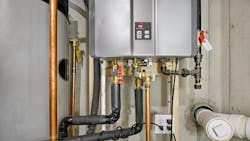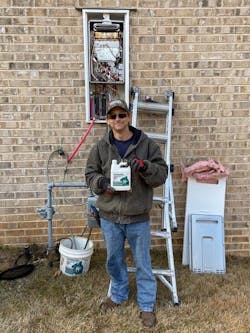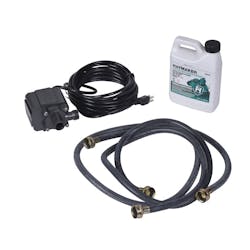Recurring Revenue, One Flush at a Time: The Business Case for Tankless Maintenance
In today’s residential and commercial plumbing landscapes, tankless water heaters have carved out a firm place thanks to their energy efficiency and compact designs. However, what often flies under the radar is how essential regular maintenance is—not just for performance but also for longevity, safety, and customer satisfaction.
Offering tankless water heater maintenance as a recurring service is more than a way to keep appliances running—it's a strategic move for plumbing and HVAC contractors that builds long-term customer relationships and opens the door to additional revenue streams.
Why Recurring Maintenance Makes Sense—for Everyone
Offering routine tankless maintenance, typically in the form of an annual or biannual flush, doubles as a mutually beneficial service agreement. For contractors, it’s a reliable income stream.
These appointments, usually taking 30–45 minutes, provide a steady workload and can often be slotted efficiently into regular routes. You can also use this free time to upsell additional services during the appointment. While you are there, you can offer to inspect any other plumbing-related issues that might concern the homeowner.
You’re providing real value to your customers. Many manufacturers require annual flushing for their warranties to remain valid. Educating homeowners on this point alone is an easy sell: neglecting maintenance can void their warranty and cost them a full replacement if issues arise.
Tim Traylor, the owner of T&T Plumbing, notes that his customers often don't realize they need to descale their tankless water heaters.
“I get a lot of calls from homeowners telling me they didn’t know descaling needed to be done, but I wouldn’t consider it a high priority for them,” he explains. “I have been providing the descaling service for almost 10 years to differentiate myself from other plumbers. I do my best to keep track, so the responsibility does not rest with the homeowner.”
Tankless water heater maintenance offers more than a service opportunity—it’s a way to:
● Deepen customer relationships
● Prevent costly breakdowns
● Educate homeowners on system care
● Generate predictable revenue
Traylor says he flushes hundreds of tankless water heaters a year. “It’s a little more every year because I’m installing more and more tankless water heaters. Once a year has passed since installation, I flush every new or retrofit install. I keep up on the one-year maintenance of each unit.”
Flushing the System (Descaling)
Tankless water heater descaling removes mineral buildup—primarily calcium and magnesium—from the heat exchanger and internal tubing. If left unchecked, scaling can lead to reduced water flow, increased energy use, and eventual corrosion or component failure. The descaling process typically involves circulating a cleaning solution through the unit for 30–45 minutes.
For potable water applications, the Haymaker Tankless Water Heater Descaler Kit is T&T Plumbing's preferred choice. The kit includes a descaling solution (citrus-based), a submersible pump, hoses, and a bucket.
Traylor takes it a step further by leaving a Haymaker kit behind with the homeowner after installation: “That way, they can either do it themselves or call us back. We include it in the install price, so there’s no barrier.”
In hard-water regions, scaling can reduce water pressure, clog narrow tubes, and lead to total heat exchanger failure. Traylor recalls one instance where a heat exchanger began leaking just four months after a flush—proof that in areas with poor water quality, descaling may need to occur more frequently than annually.
David Williams, owner and operator of Plunger Pros Plumber & Drains, routinely depends on the Haymaker system in his fieldwork: “Whenever I encounter a calcium clog, I reach for the Haymaker solution in the kit. It consistently cleans out the blockage without fail.
“It has helped with maintenance,” he continues, “especially since we have contracts with customers to perform yearly flushes. Having the kit means I don't have to worry about its effectiveness. It does what it needs to do without any issues, consistently delivering results.”
Traylor adds, “Clients call me and note the differences in their water after the flushing. One recently told me: ‘Before you descaled my unit, our water would come out yellow and never get hot enough. Now, the water is clear, and the hot water is coming out much faster.’”
If you are looking to expand your service offerings, consider making tankless water heater maintenance a core part of your business model. The recurring nature of flushing makes it ideal for scheduling follow-ups, especially if you’re already managing water filtration, HVAC service, or drain cleaning.
Setting up simple reminder systems—whether email, calendar invites, or CRM automation—ensures you stay top of mind with clients. Some companies even offer “preferred customer” plans that include annual maintenance as part of a subscription.
Building trust and maintaining visibility are key. A company that services units responsibly, without pushing unnecessary replacements, is more likely to earn future business from satisfied homeowners.
Educating Customers
One of the strongest arguments for routine maintenance is its role in customer education. Explaining the “why” behind flushing helps homeowners understand the stakes. Without regular service, scaling can not only slow a system—it can corrode internal components, shorten the unit’s lifespan, and increase energy consumption.
This is especially true in hard-water areas, where descaling may be needed twice yearly. You should always refer to the manufacturer’s recommendation, but using the "industry standard" of annual service as a baseline is a good practice. Suggest testing local water quality to determine a more precise schedule, if possible.
How Often Should You Flush?
Industry best practice—and most manufacturer warranties—recommend annual flushing. However, frequency should be adjusted based on local water conditions:
● Hard water areas: Consider flushing every six months.
● Moderate-to-soft water areas: Annual service is usually sufficient.
● Unknown water quality: Test or err on the side of more frequent maintenance.
Warning Signs That It’s Time to Flush
Educate homeowners to watch for:
● Fluctuating water temperature
● Reduced water pressure
● Unusual noises (popping, gurgling)
● Slow hot-water delivery
● System error codes
Spotting these signs early can prevent major repairs—or even total system failure.
Other Key Maintenance Tasks
While flushing (descaling) is often considered the primary maintenance task, a full-service inspection typically includes several essential components:
● Clean the inlet water filter, which traps debris before it enters the heater. A blocked filter can reduce water flow and increase system wear.
● Check the air intake filter if the model includes one. This filter prevents debris from entering the combustion chamber, so failure to maintain it can restrict airflow, negatively affect burner performance, and potentially trigger error codes.
● Inspecting venting and combustion components is crucial for safe operation. Visual checks for blockages, such as bird nests or cobwebs, help ensure compliance with safety standards.
● Test the pressure relief (T&P) valve, a critical safety feature that releases water if pressure or temperature exceeds safe limits. A leaking or malfunctioning valve may indicate internal issues.
● Monitor any error codes or diagnostic alerts displayed by the system, as these can indicate underlying problems.
● Review system settings and firmware, if applicable, to prevent issues and ensure that the unit operates correctly, reducing the likelihood of needing repairs.
Building a Better Maintenance Culture
Tankless water heaters are reliable and efficient when properly maintained. Yet, as with many behind-the-scenes systems, homeowners often neglect them until something goes wrong. Contractors who offer recurring service agreements provide a valuable safety net.
By educating customers, using safe descaling solutions, and building annual check-ins into your service model, you’ll create long-term relationships and ensure your customers’ systems continue to perform as promised.
The smartest service pros aren’t just fixing problems—they’re preventing them. And that’s what keeps customers coming back.
About the Author
Sean Comerford
Sean Comerford is the Applications Manager at Oatey Co. He is a third-generation tradesman with nearly 20 years of plumbing experience, including serving as the lead plumber for commercial/residential new construction, service, and fire protection jobs. He holds a State of Ohio Fire Protection License for Sprinkler and Standpipe.


